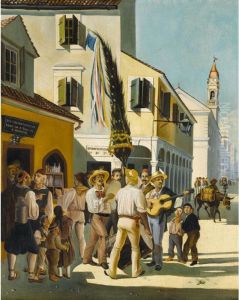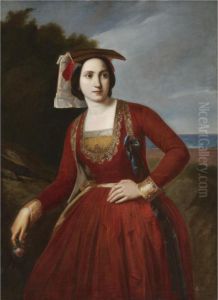Charalambos Pachis Paintings
Charalambos Pachis was a distinguished Greek painter, born in 1844 in Corfu, Greece. His work is often associated with the Heptanese School of painting, which is a term referring to a group of 19th-century artists from the Ionian Islands (of which Corfu is a part) who were influenced by both the Italian Renaissance and the Enlightenment. Pachis is particularly known for his contribution to the development of Greek art during a period of national awakening and cultural revitalization that followed Greece's independence from Ottoman rule in the early 19th century.
Pachis was initially taught by his father, who was also an artist, before pursuing his education in art more formally. He traveled to Italy, which was a common destination for Greek artists at the time, to study. There, he was exposed to the works of the Italian masters, and he absorbed elements of their style, which would later influence his own paintings.
Upon his return to Greece, Pachis quickly established himself as a prominent figure in the art scene. His works included landscapes, portraits, and historical scenes. He was particularly adept at capturing the Greek countryside and the lives of its people, often depicting them with a romanticized elegance. His portraits of notable Greek individuals of his time are also significant for their historical value.
Charalambos Pachis also played a role in the art education in Greece. He was involved in the foundation of art societies and participated in the organization of exhibitions, contributing to the creation of an art community and the promotion of Greek art both domestically and abroad.
Unfortunately, Pachis's life was relatively short, and he passed away in 1891. Despite his early death, his work had a lasting impact on Greek art, and he remains celebrated as an important figure in the country's artistic heritage. His paintings are considered national treasures and can be found in art galleries and museums throughout Greece.

